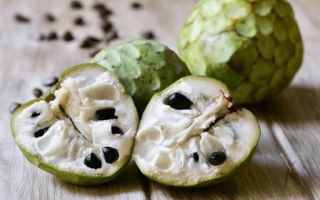Content
Cherimoya fruit is an exotic product that is not often found on store shelves. It is all the more interesting to find out what useful properties it has, how to choose it and eat it.
What does cherimoya look like and what kind of fruit is it?
The exotic cherimoya fruit comes from the Annonov family. Fruits are conical or heart-shaped, up to 20 cm long and up to 10 cm in diameter, each weighing from 0.5 to 2 kg.
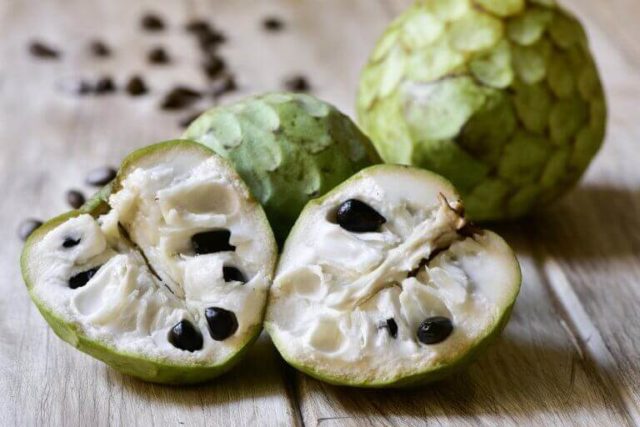
The fruits are segmented, covered with a dense skin, like scales, and inside the fruit there is a light aromatic pulp. It is creamy in consistency; 15-20 black seeds are located closer to the core.
Where and how cherimoya grows
The cherimoya fruit grows on an evergreen tree that reaches 9 m in height. The plant has branching closer to the base of the trunk; in the photo of the cherimoya tree, you can see that its branches are covered with oval dark green leaves up to 15 cm in length.

Cherimoya is native to South America - the fruit grows in Peru, Bolivia, Colombia and Ecuador. It is also artificially cultivated in Thailand, Australia, Spain, China, Malaysia and Chile.
What Cherimoya Tastes Like
The taste of exotic fruits is complex and multi-component. Gourmets claim that cherimoya is similar to banana, pineapple, strawberry, papaya and mango at the same time with a light aftertaste of cream.
The composition of vitamins and calorie content of cherimoya
The beneficial properties of cherimoye are determined by its varied chemical composition. The fruits contain:
- B vitamins - from B1 to B9, the volume of vitamin substances is from 5.8 to 13% of the daily requirement;
- vitamin C, up to 14% of ascorbic acid can be obtained from cherimoya;
- vitamin PP - about 3.2% of the daily value;
- vitamin E - about 1.8%.
The minerals in the fruit are represented by the following substances:
- potassium - about 12% of the daily value;
- copper - about 7%;
- manganese and magnesium - about 5%;
- phosphorus - slightly above 3%.
In small quantities, the fruit also contains calcium, iron, sodium and zinc. Cherimoya contains organic acids, nonessential and non-essential amino acids, saturated and unsaturated fats, sugars, fructose and glucose.
Basically, the nutrients in the fruit are carbohydrates, they are contained in cherimoya about 14.7 g. Also, the fruit contains proteins in the amount of 1.6 g and fats - about 0.7 g. The calorie content of the product per 100 g is 75 kcal, this is average nutritional indicator.
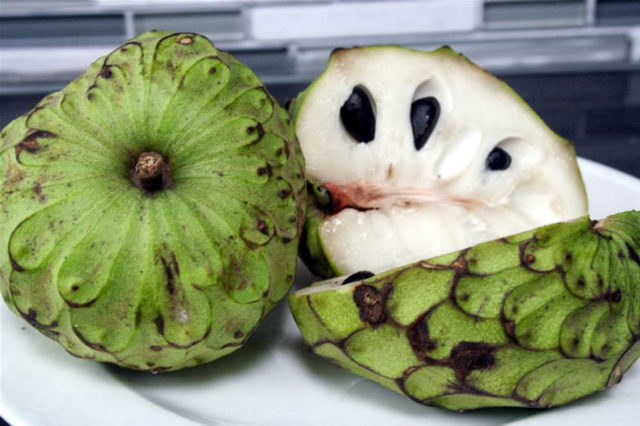
Useful properties of cherimoya
Due to its high amount of vitamins and minerals, the fruit has many health benefits. The properties of cherimoya are that it:
- increases the digestibility of nutrients entering the body with food;
- normalizes gastric acidity and prevents the development of gastritis and ulcers;
- facilitates the liver and helps to remove toxins from the body;
- helps to lose weight and get rid of excess fluids;
- helps to eliminate swelling;
- has an antiseptic effect in inflammatory processes;
- helps with colds, coughs and chronic respiratory diseases;
- removes toxins and traces of heavy metals from the body in case of poisoning;
- improves skin condition and strengthens hair;
- accelerates blood circulation and thereby protects the heart and blood vessels from ailments.
Reviews of cherimoya claim that the use of the fruit increases the charge of vivacity and gives energy, so it is useful to use it in case of stress and loss of energy. The fruit becomes very valuable with vitamin deficiency, thanks to its varied composition, it quickly eliminates the lack of vitamins.
For eye health
Cherimoya contains the substance lutein, a strong antioxidant that has a beneficial effect on the eyes. The use of cherimoya prevents cataracts and protects against vision loss.
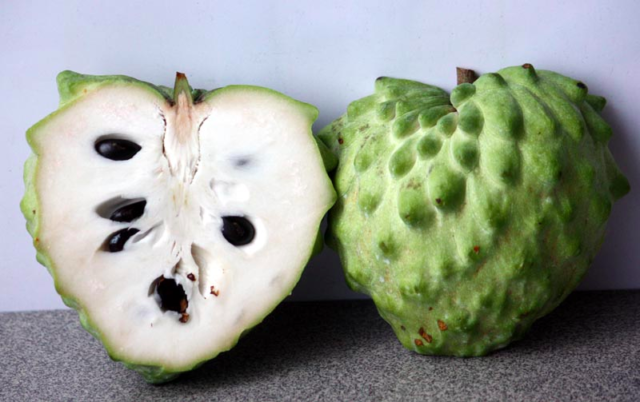
For gastrointestinal health
Dietary fiber in the composition of cherimoya allows you to regulate intestinal peristalsis and establish an emptying regime. Fatty acids of cherimoya prevent the occurrence of inflammatory processes in the intestines, serve as the prevention of ulcerative colitis and Crohn's disease.
When consumed in moderation, the fruit maintains the correct intestinal microflora and protects the body against flatulence, constipation or diarrhea.
For immunity
Cherimoya fruit contains a lot of vitamin C, which helps to quickly strengthen the immune system. As a result, the body becomes more resistant to viral infections, copes faster with inflammation and bacterial processes. Cherimoya is especially beneficial in the cold season, when the body's defenses are naturally reduced.
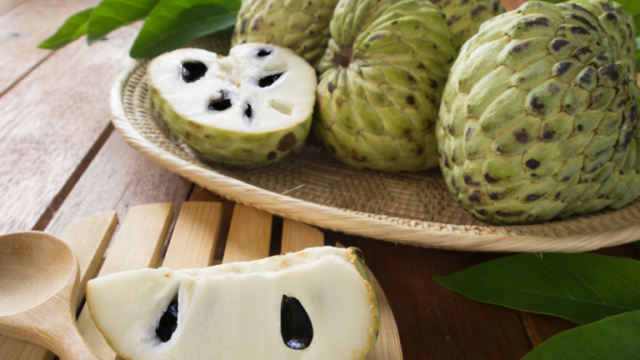
For the heart and blood vessels
The exotic fruit cherimoya contains a lot of potassium, which allows it to regulate blood pressure, accelerate blood circulation and stabilize the heart rate. In addition, the fiber in the product protects blood vessels from the formation of cholesterol plaques. The beneficial properties of cherimoya have a complex positive effect and help prevent heart attacks and strokes, which is especially useful for middle-aged men.
Prevention of oncological diseases
The tropical fruit cherimoya contains many flavonoids, such as catechin, epigallocatechin, and epicatechin. Laboratory studies have confirmed that these substances are able to slow down the growth of cancer cells, in particular, in cancers of the intestine, stomach, bladder and breast.
Including fruit in your diet is highly recommended for people with a hereditary or acquired predisposition to cancer. The beneficial properties of cherimoya can reduce the likelihood of cancer.
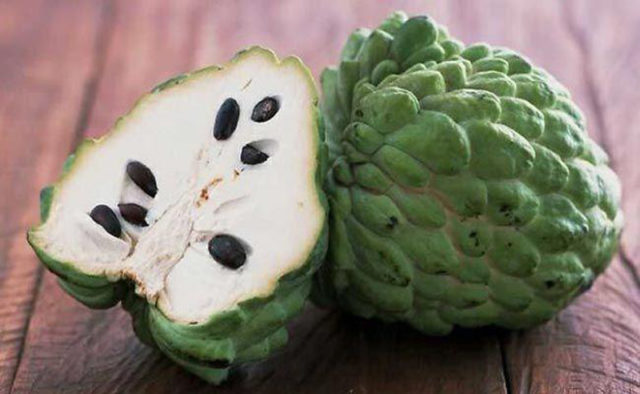
Powerful antioxidant
The beneficial properties of cherimoya are that, when consumed in moderation, it prevents the proliferation of free radicals in the body. The fruit contains many antioxidants, including ascorbic acid, kaurenic acid and carotenoids. Antioxidant compounds not only protect the body from cancerous growths, but also help maintain the heart, strengthen blood vessels, and stimulate good brain function.
Against fatigue and depression
The fruits of the tropical cherry fruit contain a large amount of B vitamins, in particular B1 and B6, which are responsible for the synthesis of serotonin and dopamine in the body. Thanks to this feature, it is able to regulate mood and eliminate symptoms of depression. It is especially useful to consume cherimoya during the period of seasonal lack of vitamins, as well as during severe psycho-emotional stress and stress.
To normalize blood pressure
Cherimoya contains high amounts of potassium and magnesium, which are trace elements responsible for blood pressure. The fruit is able to expand blood vessels and improve blood circulation, thereby preventing the development of hypertension. Since it is high blood pressure that often provokes strokes and heart attacks, the beneficial properties of an exotic fruit are in great demand in old age or with a pronounced tendency to pressure surges.
The use of cherimoya in traditional medicine
Due to its many beneficial properties, cherimoya is often used to treat ailments and painful conditions. The pulp of a tropical fruit is recommended to use:
- for constipation, cherimoya acts as a mild natural laxative and allows you to quickly establish a bowel movement;
- with hypertension and heart ailments - cherimoya should be introduced into a regular diet in order to regulate the pulse and pressure indicators, as well as cleanse the blood vessels of cholesterol;
- in case of inflammation and colds, it is useful to consume the fruit on a regular basis, since vitamin C in its composition helps to fight inflammation, eliminates viruses and infections and generally strengthens the immune system.

Infusions on fruit leaves and cherimoya essential oil are used in the fight against parasites, in particular, against lice. Also, the pulp of the fruit or the juice of cherimoya can be used to treat insect bites, cuts and healing ulcers and burns, the product will contribute to the rapid recovery of the skin.
In cosmetology
The beneficial properties of the exotic fruit are used for body and hair care. Vitamins in the composition of the fruit allow you to maintain the smoothness and youthfulness of the skin, help fight dry skin and the first wrinkles.
Some recipes:
- If you knead cherimoya fruits into gruel and mix with yogurt or sour cream, then the mask obtained with regular use can whiten the skin and eliminate age spots.
- In combination with cosmetic oils, such as olive or almond oils, the beneficial properties of cherimoya effectively moisturize the skin and prevent it from flaking and cracking.
Cherimoya essential oil is used in combination with base oils to eliminate dandruff. And if you dilute dry fruit seed powder with water and apply it to your hair for half an hour, it will help get rid of lice.
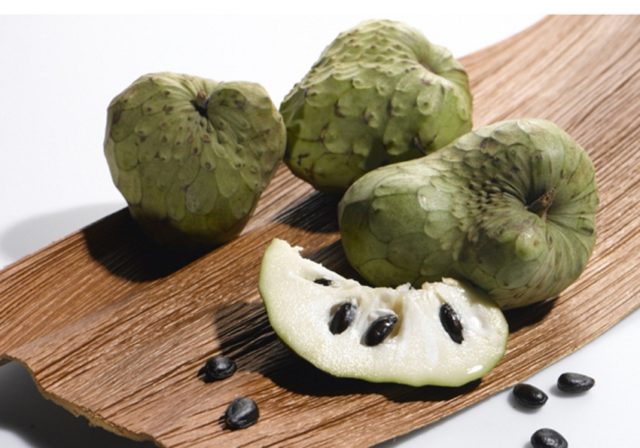
How to eat cherimoya
A tropical fruit is rarely found on shelves in Russia, so many people have a question about how to eat it. The video on how to eat cherimoya demonstrates that it is very simple. The fruit is cut in half along the direction, and then remove the pulp from the halves using a spoon.
Most often, the fruit is eaten fresh, but frozen cherimoya also tastes great, it becomes similar to sweet sorbet or creamy ice cream with fruit additives. The fruit is used in the preparation of desserts, pastries, cakes, mousses and creams, the treats are not only tasty, but also very useful.
Is it possible to eat cherimoya seeds
In the fruits of a tropical fruit, there are 15-20 black hard seeds of medium size. It is forbidden to swallow them or specially consume them raw and fried; toxic substances in the composition can lead to poisoning with cherimoya seeds and cause indigestion.
At the same time, after processing and in small quantities, bones and powder based on them can be used against parasites. However, cherimoya seed extract is used mainly externally so as not to harm health.
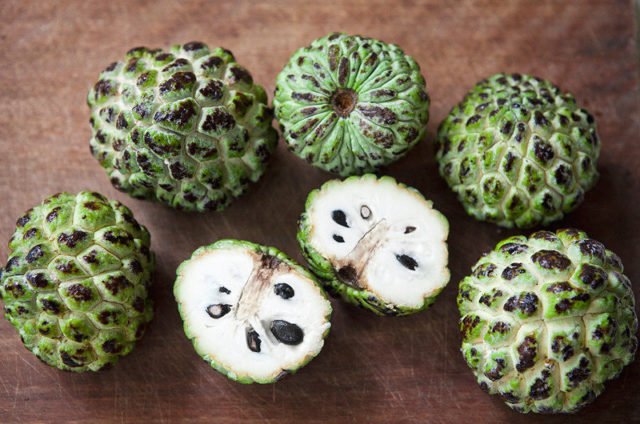
How to choose cherimoya
Choosing a ripe cherimoya fruit can be difficult, not everyone knows what a quality product should look like. When buying, you need to pay attention to the following parameters:
- Color, fruit peel should be uniformly green, without light and too dark areas;
- integrity - there should be no cracks, dents or other damage on the peel, while the fruit should be soft enough to the touch;
- mass, the fruit should be quite weighty, it is recommended to choose specimens with a weight of at least 500 g.
The stalk of a ripe cherimoya should be cut short. The peel of the fruit should not be too dry, if wrinkled overdried areas are visible on the surface, then there is a high probability that the pulp will also be overripe and tasteless.
Storage rules
Fresh fruit is stored for a short time, at a temperature of about 8 ° C and moderate humidity in the region of 60% cherimoya retains its taste and useful properties for only about 3 days. You need to keep cherimoya fruits in the refrigerator, and so that they do not deteriorate ahead of time, they are wrapped in a paper towel or thin plastic wrap.
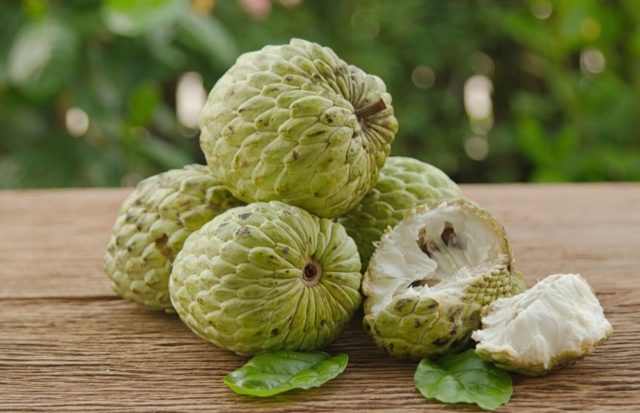
Limitations and contraindications
Tropical cherimoya is not always beneficial to the body. In some cases, its properties can be harmful to health. It is not recommended to eat fruits:
- with diabetes mellitus - sweet fruit contains a lot of simple carbohydrates and natural sugars, therefore, it can provoke a sharp increase in glucose levels;
- with exacerbations of digestive ailments - stomach ulcers, pancreatitis, colitis and gastritis with high acidity are contraindications for the fruit, although during the period of remission it is not forbidden to consume cherimoya fruits;
- with individual allergies.
It is necessary to taste the fruit with caution during pregnancy and breastfeeding. Do not allow fresh cherimoya juice to come into contact with your eyes. It is strictly forbidden to gnaw, chew or swallow the hard pits of the fruit, they cause serious food poisoning.
Conclusion
Cherimoya fruit is a very unusual but tasty product with numerous health benefits. When using it, you need to be careful and remember about possible contraindications, however, with reasonable use, the fruit will strengthen health and improve well-being.

